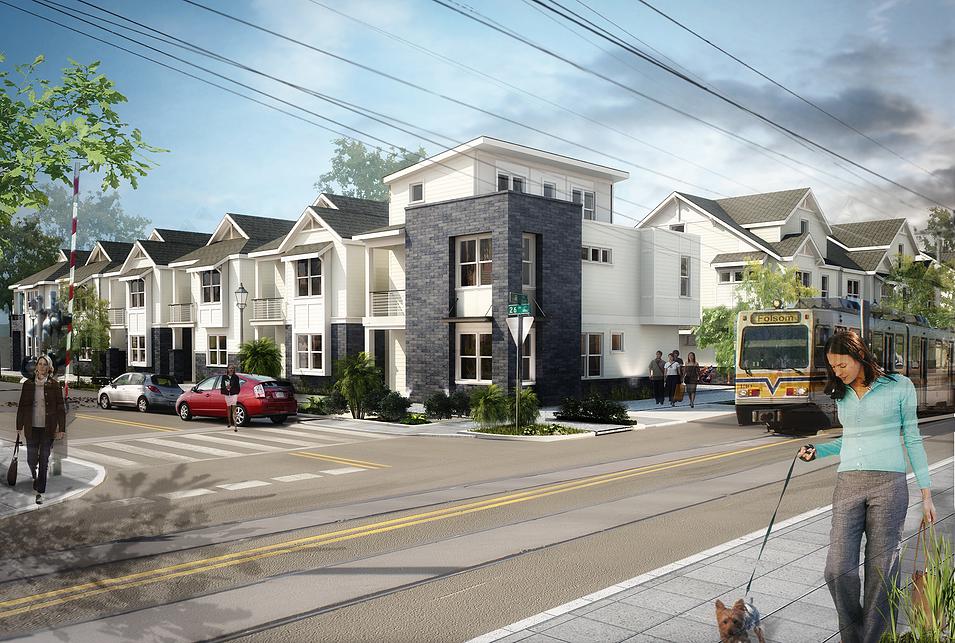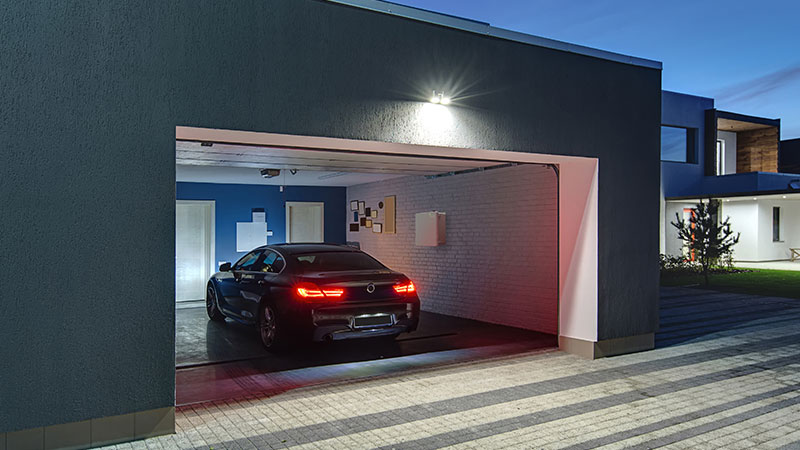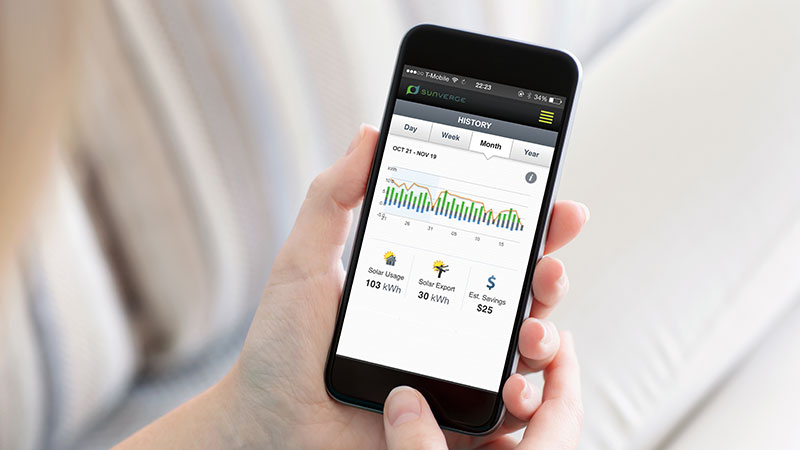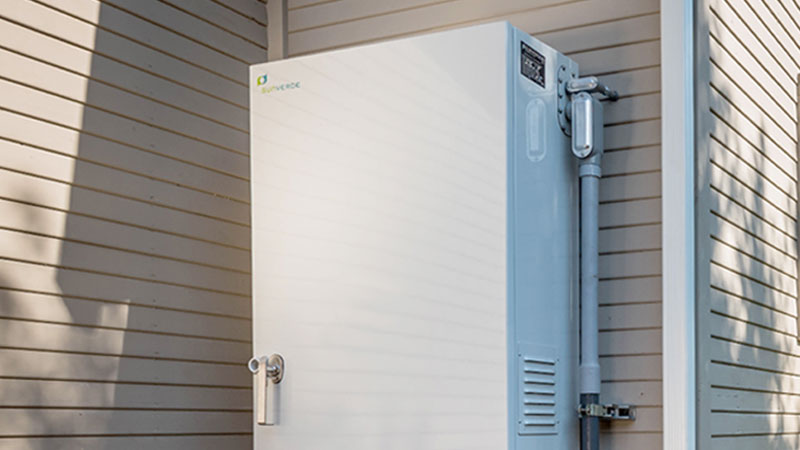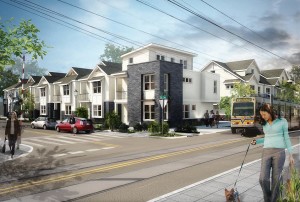
Artist rendering of the completed 2500 R Midtown affordable housing community. (Courtesy: Pacific Housing)
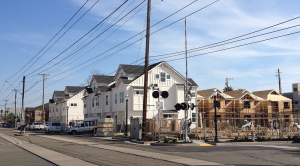 The 2500 R Midtown affordable housing community under construction. (Courtesy: Pacific Housing
The homes, built by Pacific Housing, a non-profit focused on affordable housing, sold out in less than a year at modest price points of $350,000 to $450,000 for homes of 1,250 to 1,700 square feet. The solar energy systems were included in the homes’ prices, which means these homeowners pay no lease or operating fee while enjoying incredibly low electrical bills thanks to a Sunverge battery system that stores the sun’s energy in an 11.64 kWh battery system during the day, releasing it when people arrive home from work, when peak demand often occurs on the local grid.
The solar-battery systems not only increased the cachet of the homes to green-minded buyers, helping the project sell out swiftly, but they also offered to appeal to budget-conscious families looking for homes that were cheap to buy and operate.
“The demographic to whom we sell homes is one for which every penny counts,” says Mark Wiese, CEO of Pacific Housing. “For some of our buyers, $30 a month is a big deal—so this kind of permanent savings on the energy bill really helps. This has been a great draw, a great feature to help sell this project so quickly.”
The 2500 R Midtown affordable housing community under construction. (Courtesy: Pacific Housing
The homes, built by Pacific Housing, a non-profit focused on affordable housing, sold out in less than a year at modest price points of $350,000 to $450,000 for homes of 1,250 to 1,700 square feet. The solar energy systems were included in the homes’ prices, which means these homeowners pay no lease or operating fee while enjoying incredibly low electrical bills thanks to a Sunverge battery system that stores the sun’s energy in an 11.64 kWh battery system during the day, releasing it when people arrive home from work, when peak demand often occurs on the local grid.
The solar-battery systems not only increased the cachet of the homes to green-minded buyers, helping the project sell out swiftly, but they also offered to appeal to budget-conscious families looking for homes that were cheap to buy and operate.
“The demographic to whom we sell homes is one for which every penny counts,” says Mark Wiese, CEO of Pacific Housing. “For some of our buyers, $30 a month is a big deal—so this kind of permanent savings on the energy bill really helps. This has been a great draw, a great feature to help sell this project so quickly.”
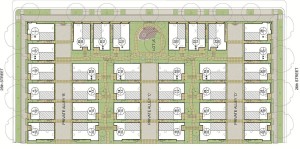 Site plan for the 2500 R Midtown affordable housing community. (Courtesy: Pacific Housing)
The cooperation from the local utility, Sacramento Municipal Utility District (SMUD), along with the success of the installation and the clear demand from the market, have led us to plan another set of Sunverge installations in an affordable housing project in Sacramento. Construction begins this summer on Heritage Del Paso Nuevo, just a few miles from downtown, will feature 90 homes, each with its own solar energy storage system—these ones even more advanced than those installed at 2500R. These homes will be offered at price points of $250,000 to $270,000.
That puts these houses, which will be energy net-zero, well below the average new home price in the United States of $343,000, and even below the median of $277,000.
SMUD, the local utility and the only one in California to receive more than 20 percent of its energy from renewables, is excited to have the first net-zero housing developments on the West Coast on its grid.
At Sunverge, we feel this is a breakthrough for the entire industry. PV storage systems have now proven themselves to be compatible with any kind of home and price point. The industry is well-positioned to adhere to California’s legislation stipulating that all new homes need to be energy net-zero by 2020. We’re already there, five years early and under budget.
Ken Munson is CEO of Sunverge Energy.
Site plan for the 2500 R Midtown affordable housing community. (Courtesy: Pacific Housing)
The cooperation from the local utility, Sacramento Municipal Utility District (SMUD), along with the success of the installation and the clear demand from the market, have led us to plan another set of Sunverge installations in an affordable housing project in Sacramento. Construction begins this summer on Heritage Del Paso Nuevo, just a few miles from downtown, will feature 90 homes, each with its own solar energy storage system—these ones even more advanced than those installed at 2500R. These homes will be offered at price points of $250,000 to $270,000.
That puts these houses, which will be energy net-zero, well below the average new home price in the United States of $343,000, and even below the median of $277,000.
SMUD, the local utility and the only one in California to receive more than 20 percent of its energy from renewables, is excited to have the first net-zero housing developments on the West Coast on its grid.
At Sunverge, we feel this is a breakthrough for the entire industry. PV storage systems have now proven themselves to be compatible with any kind of home and price point. The industry is well-positioned to adhere to California’s legislation stipulating that all new homes need to be energy net-zero by 2020. We’re already there, five years early and under budget.
Ken Munson is CEO of Sunverge Energy. 